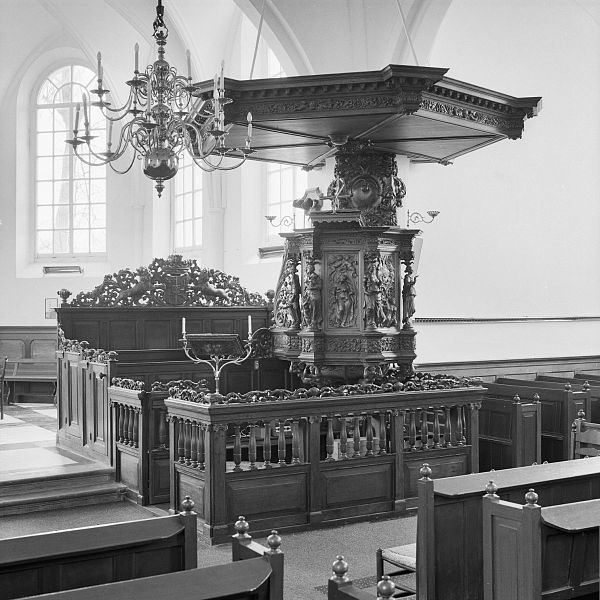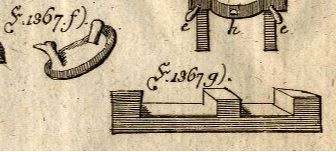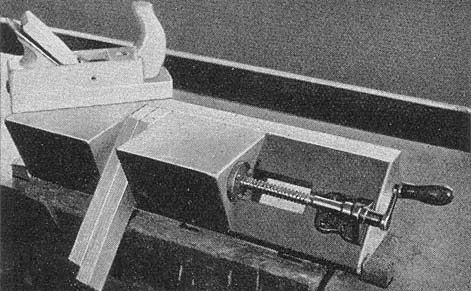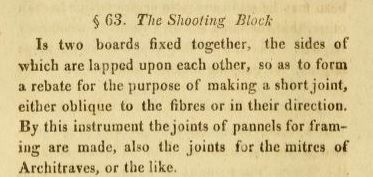I posted this on woodnet, but I thought, why not share it here too?
Randle Holme (1688), Felibien (1690), Moxon (1683). These three have descriptions of the tools used by joiners. In none of their books is a shooting board. Moxon uses the word shooting where we would say jointing. He describes how to mitre a moulding. Hold the moulding up in your right hand and the plane in the left hand, sole upwards, and thrust the moulding over the edge.
Johann Hübner (1714) Curieuses und Reales Natur- Kunst- Berg- Gewerck- und Handlungs-Lexicon.
There are two places in this dictionary with a shootingboard (stossladen). In both instances the shootingboard is explictly described to be used for miters.
Roubo (1769 - 1774)is a bit difficult for me. I don't read French very well. The book about marquetry has been translated in English by Lost art press. Plate 289 has something that could be called a shooting jig, used to reproduce exact copies of the various veneer pieces. I found the German translation on Google books from the Tischler part (the cabinetmakers). The quality of the scan is particularly bad, but the images are well known. Nothing that looks like a shootingboard and there is also nothing in the text about the tools, and not in the text about how to make joints either. Roubo is very complete and accurate. If they would have used shootingboards in Paris at that time, I'm sure it would have been in the book.
I have also browsed through P.N. Sprengel, Vierter Abschnit, Der Tischler (1778). In this book, exactly like in the German dictionary from 1714, the shooting board is mentioned again with the explicit note that it is used for miters. Later in this book all the different methods to work wood in furniture making are described but I can't find any reference to a shooting board there. The endgrain of a board prepared for dovetails is planed with the board in the vise.
The Germans knew two kinds of these shootingboards. The Stosslade, used for miters. And the Kropflade. This is used for mouldings which fold around a column or the like which juts out in front of the main surface. There are some nice pictures of these two shootingboards in a book from Kunitz, Oekonomische Encyklopädie. The plane used for these devices is the Vergatthobel. Peculiar about these planes is that they rarely have a flat side. In other words, they can't be used on a shootingboard like we know it today.I have no idea how to interpret the drawings of these stossladen or how they were used.I wonder if these old German devices were a precursor for the shooting block which was made until recently by Ulmia. On these things you can use any plane in normal position, because it doesn't need to reference on its side.
Kropflade:
Stosslade and vergatthobel:
And another Vergatthobel:
And a more modern German shootingblock:
Peter Nicholson, Mechanical exercises (1812). Here is the first instance of a shooting board as we know it! It's called a shooting block.
The Joiner and cabinetmaker, anonymous (1839). This book describes the apprentenceship from Thomas. When he makes his first dovetailed box, the shooting board is being presented, and used of course. When he makes a mortise and tenon joint later in the book, a shooting board is not used and the shoulderlines are marked with a square.
So, the shooting board like we know it today seems to be introduced in the 19th century. In the 17th and 18th century they probably didn't use shootingboards for square corners, but they did have devices and special planes for shooting mitres in Germany.
And just to show some terific cabinetmakers work from 1708, illustrating how skilled they were while using comparatively simple tools, here is a picture of the lectern from the Maria Church in Uithuizermede made by the joiner Allert Meijer. These guys never cease to impress me.










 Reply With Quote
Reply With Quote




